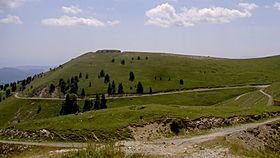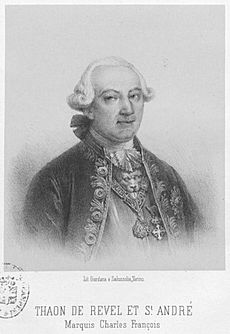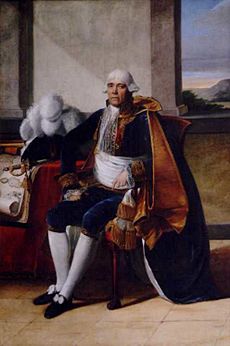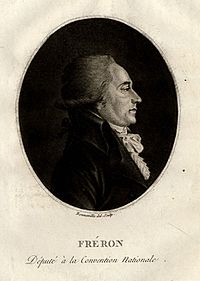First Battle of Saorgio (1793) facts for kids
Quick facts for kids First Battle of Saorgio |
|||||||
|---|---|---|---|---|---|---|---|
| Part of the French Revolutionary Wars | |||||||
 Fort de La Forca on the Massif de l’Authion |
|||||||
|
|||||||
| Belligerents | |||||||
| Commanders and leaders | |||||||
| Strength | |||||||
| 10,000–12,000 | 17,000 | ||||||
| Casualties and losses | |||||||
| unknown | 1,532 | ||||||
The First Battle of Saorgio took place from June 8 to 12, 1793. It was a fight between the French army and the combined armies of Sardinia-Piedmont and Austria. The French army was led by Gaspard Jean-Baptiste Brunet. The Sardinian and Austrian forces were commanded by Joseph Nikolaus De Vins and Charles-François Thaon, Count of Saint-André.
Even though the French had some early success, their main attacks failed. They tried to capture strong defensive positions on the Massif de l'Authion and the Col de Raus. These attacks resulted in many French losses. Saorgio, where the battle happened, is now in France. But in 1793, it was part of Piedmont. About a year later, in April 1794, the French finally took these positions in the Second Battle of Saorgio.
Contents
Background to the Battle
Armies Prepare for War
In the winter of 1792, two French armies were facing the Kingdom of Sardinia. The Army of the Alps was in the north, and the Army of Italy was in the south near Nice. The Army of Italy had about 21,728 soldiers ready for battle.
The French government wanted to attack the island of Sardinia. So, they replaced the commander of the Army of Italy, Jacques Bernard d'Anselme, with Gaspard Jean-Baptiste Brunet. Brunet led an expedition to Sardinia, but it failed completely within two months. After that, Armand Louis de Gontaut, Duke of Biron took command of the Army of Italy in February 1793. He moved his troops eastward along the Mediterranean Sea.
Sardinia's Defenses
King Victor Amadeus III of Sardinia was worried about his army's performance. He asked Austria to send a top commander, and Joseph Nikolaus De Vins arrived in December. However, Austria suspected Sardinia might try to make peace with France on its own.
The French tried to create problems between Sardinia and Austria. But when the French King Louis XVI was executed in January 1793, King Victor Amadeus III refused to deal with France.
In the spring, Sardinia's defenses were set up from north to south. Different commanders protected various mountain passes and valleys. In the very south, Charles-François Thaon, Count of Saint-André commanded 10,000 to 12,000 soldiers. Their job was to defend Saorgio and threaten Nice.
Early Fights
On February 28, 1793, there was a fight at Levens. Biron's 12,000 French soldiers defeated 7,000 Sardinians led by the Count of Saint-André. Both sides lost about 800 soldiers. The Sardinians also lost two of their six cannons.
At this time, Sardinian soldiers were better at fighting in the mountains. French troops often got lost in the forests and foggy valleys. The French Army of Italy moved east, taking control of the lower Var and Vésubie valleys. They also occupied Sospel.
By March, the Army of Italy had 17,000 soldiers. A rising young officer named André Masséna was in charge of five battalions. The French government often moved commanders around. So, Biron was transferred to lead another army in May 1793. Even though Biron was loyal to France, some powerful political groups, called the Jacobins, didn't trust him because he was from a noble family. He was later removed from command and sadly lost his life.
By the end of March 1793, Saint-André's forces were organized into two main groups. The Left Division had about 7,050 soldiers. The Right Division had about 5,200 soldiers. Austrian troops also joined them, including the Belgiojoso Infantry Regiment.
The Battle of Saorgio
Brunet replaced Biron as commander of the Army of Italy. In May and June, the French army began to move closer to Saint-André's main defenses. On May 19, Brunet sent Jean-Mathieu-Philibert Sérurier with 3,000 soldiers to Saint-Sauveur-sur-Tinée. From there, they advanced up the Tinée River and captured Isola on May 21. The Sardinians left the upper Tinée valley. Sérurier then returned to the Army of Italy.
The main Sardinian defenses were around the town of Saorgio. Saorgio is located on the east bank above the deep valley of the Roya River. From Saorgio, a line of forts and trenches stretched west. Key points included the Saint-Martha camp, Colle Basse, Massif de l'Authion, and Col de Raus. The village of Roquebillière was at the western end of this defensive line.
The Austro-Sardinian forces had some leadership problems. Two Austrian generals, Michelangelo Alessandro Colli-Marchi and De Vins, were helping the Sardinians. But Colli and his superior, Saint-André, did not get along well. This made things difficult for their army.
French political leaders, called "representatives on mission," kept pushing for direct attacks. They even threatened generals who seemed hesitant. Brunet started his attack on June 8. His troops had some success, with André Masséna playing a part. They captured the Linieras camp and Mangiabo.
However, on the same day, Sérurier and 3,000 soldiers were pushed back when they attacked the Col de Raus. This pass was about 5 kilometers (3 miles) northwest of Authion.
On June 12, Brunet tried again with a direct assault on the artillery battery at Authion. Sérurier led one of the attacking groups, which were mostly made up of the army's best soldiers, called grenadiers. The French charged bravely three times. But they were finally forced to retreat after an Austrian counterattack.
The French supporting fire was weak, while the Sardinian cannons were placed very well to hit the attackers from the side. As the first French lines fell back, some of the new, inexperienced soldiers in the reserves panicked and ran away. Seeing this, Brunet decided that nothing more could be done. He ordered a retreat. The French lost 280 soldiers killed and 1,252 wounded. The number of Austro-Sardinian losses is not known.
Forces in the Battle
Austro-Sardinian Troops
Historians say that Saint-André led the allied forces at Saorgio. However, records show that the Duke of Chablais was in overall command. His army was divided into a Left Division under Saint-André and a Right Division under Colli.
The Left Division included soldiers from several Sardinian infantry regiments, like Nice, Queen's, Saluzzo, Tortona, Vercelli, and Sardinia. It also had grenadier and light battalions. Austrian troops were also part of this division.
The Right Division had soldiers from Sardinian regiments like Casale, Lombardy, and Christ. It also included grenadier battalions and the Light Legion. Austrian Belgiojoso troops and French Royalists were also present.
French Troops
On June 7, 1793, François Christophe Kellermann was in charge of both his own army and the Army of Italy under Brunet. Jean François Cornu de La Poype was Brunet's chief of staff, and Jean du Teil commanded the army's artillery.
The French army had both regular soldiers and volunteer battalions. Elite units were formed by taking grenadier and chasseur (light infantry) companies from their larger battalions.
About 9,000 French soldiers were stationed in towns along the French Riviera. These included Antibes, Monaco, Nice, Saint-Laurent-du-Var, Toulon, and Villefranche-sur-Mer. Additional volunteer battalions were at Camp Diegue and Castillon.
In the Roya Valley, on the right side of the French line, there were 7,052 soldiers. These included grenadiers, chasseurs, and regular infantry from the 28th, 51st, and 91st Line Infantry Regiments. There were also volunteer battalions and artillery companies.
On the left side, in the Tinée and Vésubie valleys, there were 6,057 troops. These were stationed at places like Saint-Sauveur, Utelle, La Bollène-Vésubie, Lantosque, and Roquebillière. They included regular infantry from the 42nd and 50th Line Infantry Regiments, as well as volunteers, grenadiers, and artillery.
An additional 3,618 troops were in the center. They were at Saint-Arnould, Col Negre, and Lucéram.
What Happened Next
Under pressure from political leaders, Brunet launched another attack on the Massif de l'Authion and Col de Raus in late July. This attack also failed. However, the connection between the Army of Italy and the Army of the Alps improved. Brunet suggested a plan to go through neutral territory belonging to the Republic of Genoa to attack Saorgio from the side. But this plan didn't happen.
One of the political leaders, Paul Barras, was impressed by Sérurier's actions. So, he nominated Sérurier for a promotion. Both Masséna and Sérurier were promoted to general of brigade in August 1793.
Brunet had disagreements with powerful politicians named Louis-Marie Stanislas Fréron and Barras. Brunet correctly predicted that the city of Toulon might let in enemy forces if the political leaders were too harsh. He refused to send troops to force the city to obey. Because of this, Fréron and Barras removed him from command in August and replaced him with Pierre Jadart Dumerbion.
When Toulon allowed the Allied fleet to enter in August, Brunet was accused of being a traitor. He was imprisoned in Paris in September and sadly lost his life in November.
The next year, a young artillery commander named Napoleon Bonaparte joined the Army of Italy. He suggested a new plan to attack eastward through Genoese territory to capture Oneglia. This would allow the French to attack Saorgio from the east, going around its defenses.
The plan was approved in April 1794. Dumerbion's attack began four days later. In the Second Battle of Saorgio, the French captured Oneglia, then Ormea, and Garessio. They then turned west and attacked Saorgio from the northeast in late April. The Sardinians, led by Colli, were completely outflanked (surrounded from the side). They had to retreat, and the French occupied Saorgio on April 28.
Images for kids








